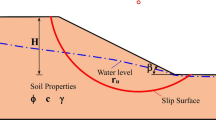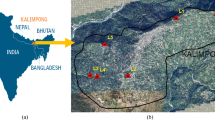Abstract
Slope engineering is a complex nonlinear system. It is difficult to respond with a high level of precision and efficiency requirements for stability assessment using conventional theoretical analysis and numerical computation. An ensemble learning algorithm for solving highly nonlinear problems is introduced in this paper to study the stability of 444 slope cases. Different ensemble learning methods [AdaBoost, gradient boosting machine (GBM), bagging, extra trees (ET), random forest (RF), hist gradient boosting, voting and stacking] for slope stability assessment are studied and compared to make the best use of the large variety of existing statistical and ensemble learning methods collected. Six potential relevant indicators, \(\gamma\), C, \(\varphi\), \(\beta\), H and \(r_{u}\), are chosen as the prediction indicators. The tenfold CV method is used to improve the generalization ability of the classification models. By analysing the evaluation indicators AUC, accuracy, kappa value and log loss, the stacking model shows the best performance with the highest AUC (0.9452), accuracy (84.74%), kappa value (0.6910) and lowest log loss (0.3282), followed by ET, RF, GBM and bagging models. The analysis of engineering examples shows that the ensemble learning algorithm can deal with this relationship well and give accurate and reliable prediction results, which has good applicability for slope stability evaluation. Additionally, geotechnical material variables are found to be the most influential variables for slope stability prediction.













Similar content being viewed by others
References
Aljamaan H, Alazba A (2020) Software defect prediction using tree-based ensembles. In: Proceedings of the 16th ACM international conference on predictive models and data analytics in software engineering, pp 1–10
Anitescu C, Atroshchenko E, Alajlan N, Rabczuk T (2019) Artificial neural network methods for the solution of second-order boundary value problems. Comput Mater Contin 59(1):345–359
Bradley P (1997) The use of the area under the ROC curve in the evaluation of machine learning algorithms. Pattern Recogn 30(7):1145–1159
Breiman L (1996) Bagging predictors machine learning. Mach Learn 24:123–140
Chakraborty A, Goswami D (2017) Prediction of slope stability using multiple linear regression (MLR) and artificial neural network (ANN). Arab J Geosci 10(17):385
Chen L, Peng Z, Chen W, Peng W, Wu Q (2009) Artificial neural network simulation on prediction of clay slope stability based on fuzzy controller. J Cent South Univ (Sci Technol) 40(5):1381–1387
Chen C, Xiao Z, Zhang G (2011) Stability assessment model for epimetamorphic rock slopes based on adaptive neuro-fuzzy inference system. Electron J Geotech Eng 16:93–107
Cheng M, Hoang ND (2015) Typhoon-induced slope collapse assessment using a novel bee colony optimized support vector classifier. Nat Hazards 78(3):1961–1978
Dickson M, Perry GLW (2016) Identifying the controls on coastal cliff landslides using machine-learning approaches. Environ Model Softw 76:117–127
Dietterich TG (1997) Machine learning research: four current directions. AI Mag 18(4):97–136
Dietterich TG (2000) An experimental comparison of three methods for constructing ensembles of decision trees: bagging, boosting, and randomization. Mach Learn 40(2):139–157
Drucker H, Schapire R, Simard P (1993) Boosting performance in neural networks. Int J Pattern Recogn Artif Intell 7(04):705–719
Duncan JM (1996) State of the art: limit equilibrium and finite-element analysis of slopes. J Geotech Eng 123(7):577–596
Fattahi H (2017) Prediction of slope stability using adaptive neuro-fuzzy inference system based on clustering methods. J Min Environ 8(2):163–177
Feng X, Hudson J (2004) The ways ahead for rock engineering design methodologies. Int J Rock Mech Min Sci 41(2):255–273
Feng X, Wang Y, Lu S (1995) Neural network estimation of slope stability. J Eng Geol 3(4):54–61
Freund Y, Schapire RE (1997) A decision-theoretic generalization of on-line learning and an application to boosting. J Comput Syst Sci 55(1):119–139
Friedman JH (2001) Greedy function approximation: a gradient boosting machine. Ann Stat 29(5):1189–1232
Gounaridis D, Koukoulas S (2016) Urban land cover thematic disaggregation, employing datasets from multiple sources and RandomForests modeling. Int J Appl Earth Observ Geoinf 51:1–10
Griffiths D, Lane P (1999) Slope stability analysis by finite elements. Geotechnique 49(3):387–403
Gutta S, Wechsler H (1996) Face recognition using hybrid classifier systems. In: Proceedings of international conference on neural networks (ICNN'96). IEEE.
He F, Wu S, Zhang Y, Bao H (2004) A neural network method for analyzing compass slope stability of the highway. Acta Geosici Sin 25(1):95–98
Hoang ND, Pham AD (2016) Hybrid artificial intelligence approach based on metaheuristic and machine learning for slope stability assessment: a multinational data analysis. Expert Syst Appl 46:60–68
Hong H, Liu J, Bui D, Pradhan B, Acharya TD, Pham B, Zhu A, Chen W, Ahmad B (2018) Landslide susceptibility mapping using J48 Decision Tree with AdaBoost, Bagging and Rotation Forest ensembles in the Guangchang area (China). CATENA 163:399–413
Hosmer J, Lemeshow S, Sturdivant RX (2013) Applied logistic regression. Wiley, New York
Jin L, Feng W, Zhang J (2004) Maximum likelihood estimation on safety coefficiefficients of rocky slope near dam of Fengtan project. Chin J Rock Mech Eng 23(11):1891–1894
Kang F, Li J, Ma Z (2013) An artificial bee colony algorithm for locating the critical slip surface in slope stability analysis. Eng Optim 45(2):207–223
Kuhn M, Johnson K (2013) Applied predictive modeling. Springer, Berlin
Lee T, Lin H, Lu Y (2009) Assessment of highway slope failure using neural networks. J Zhejiang Univ 10(1):101–108
Li J, Wang F (2010) Study on the forecasting models of slope stability under data mining. In: Earth and space 2010: engineering, science, construction, and operations in challenging environments, pp 765–776
Li W, Yang S, Chen E, Qiao J, Dai L (2006) Neural network method of analysis of natural slope failure due to underground mining in mountainous areas. Yantu Lixue (Rock Soil Mech) 27(9):1563–1566
Lin H, Chang S, Wu J, Juang H (2009) Neural network-based model for assessing failure potential of highway slopes in the Alishan, Taiwan Area: pre-and post-earthquake investigation. Eng Geol 104(3–4):280–289
Lin S, Zheng H, Jiang W, Li W, Sun G (2020) Investigation of the excavation of stony soil slopes using the virtual element method. Eng Anal Bound Elem 121:76–90
Lin Y, Zhou K, Li J (2018) Prediction of slope stability using four supervised learning methods. IEEE Access 6:31169–31179
Liu Z, Shao J, Xu W, Chen H, Zhang Y (2014) An extreme learning machine approach for slope stability evaluation and prediction. Nat Hazards 73(2):787–804
Lu P, Rosenbaum M (2003) Artificial neural networks and grey systems for the prediction of slope stability. Nat Hazards 30(3):383–398
Manouchehrian A, Gholamnejad J, Sharifzadeh M (2014) Development of a model for analysis of slope stability for circular mode failure using genetic algorithm. Environ Earth Sci 71(3):1267–1277
Marjanović M, Kovačević M, Bajat B, Voženílek V (2011) Landslide susceptibility assessment using SVM machine learning algorithm. Eng Geol 123(3):225–234
Michalowski LR (1995) Slope stability analysis: a kinematical approach. Geotechnique 45(2):283–293
Pedregosa F, Varoquaux G, Gramfort A, Michel V, Thirion B (2011) Scikit-learn: machine learning in python. J Mach Learn Res 12:2825–2830
Qi C, Tang X (2018) A hybrid ensemble method for improved prediction of slope stability. Int J Numer Anal Methods Geomech 42(15):1823–1839
Qi C, Tang X (2018) Slope stability prediction using integrated metaheuristic and machine learning approaches: a comparative study. Comput Ind Eng 118:112–122
Sakellariou M, Ferentinou M (2005) A study of slope stability prediction using neural networks. Geotech Geol Eng 23(4):419–445
Samui P (2008) (2008) Slope stability analysis: a support vector machine approach. Environ Geol 56(2):255–267
Schapire RE, Singer Y (1999) Improved boosting algorithms using confidence-rated predictions. Mach Learn 37(3):297–336
Shimshoni Y, Intrator N (1998) Classification of seismic signals by integrating ensembles of neural networks. IEEE Trans Signal Process 46(5):1194–1201
Simm J, Abril I (2014) Extratrees: extremely randomized trees (ExtraTrees) method for classification and regression. R package version 1.0. 5.
Sun G, Lin S, Zheng H, Tan Y, Sui T (2020) The virtual element method strength reduction technique for the stability analysis of stony soil slopes. Comput Geotech 119:103349
Wang CH (2004) Study on prediction methods for high engineering slope. Master thesis
Wang L, Wu C, Tang L, Zhang W, Lacasse S, Liu H, Gao L (2020) Efficient reliability analysis of earth dam slope stability using extreme gradient boosting method. Acta Geotech 15(11):3135–3150
Wang H, Xu W, Xu R (2005) Slope stability evaluation using back propagation neural networks. Eng Geol 80(3–4):302–315
Wen S, La H, Wang C (2013) Analysis of influence factors of slope stability. Appl Mech Mater Trans Tech Publ 256:34–38
Wolpert DH (1992) Stacked generalization. Neural Netw 5(2):241–259
Xiao Z, Chen C, Ji Y (2011) Applying adaptive neuro-fuzzy inference system to stability assessment of reservoir slope. Bull Soil Water Conserv 31(5):186–190
Xu W, Shao J (1998) Artificial neural network analysis for the evaluation of slope stability. Application of numerical methods to geotechnical problems. Springer, Berlin, pp 665–672
Xu F, Xu W, Wang K (2009) Slope stability analysis using least square support vector machine optimized with ant colony algorithm. J Eng Geol 17(2):253–257
Yan X, Li X (2011) Bayes discriminant analysis method for predicting the stability of open pit slope. In: 2011 International conference on electric technology and civil engineering (ICETCE). IEEE, pp 147–150
Yun L, Keping Z, Jielin L (2018) Prediction of slope stability using four supervised learning methods. IEEE Access 6:31169–31179
Zhao H, Yin S, Ru Z (2012) Relevance vector machine applied to slope stability analysis. Int J Numer Anal Meth Geomech 36(5):643–652
Zheng F, Leung YF, Zhu J, Jiao Y (2019) Modified predictor-corrector solution approach for efficient discontinuous deformation analysis of jointed rock masses. Int J Numer Anal Meth Geomech 43(2):599–624
Zheng F, Zhuang X, Zheng H, Jiao Y, Timon R (2020) Kinetic analysis of polyhedral block system using an improved potential-based penalty function approach for explicit discontinuous deformation analysis. Appl Math Model 82:314–335
Zhou Z, Jiang Y, Yang Y, Chen S (2002) Lung cancer cell identification based on artificial neural network ensembles. Artif Intell Med 24(1):25–36
Zhou J, Li X, Mitri HS (2015) Comparative performance of six supervised learning methods for the development of models of hard rock pillar stability prediction. Nat Hazards 79(1):291–316
Zhou J, Li E, Yang S, Wang M, Mitri H (2019) Slope stability prediction for circular mode failure using gradient boosting machine approach based on an updated database of case histories. Saf Sci 118:505–518
Zhou S, Rabczuk T, Zhuang X (2018) Phase field modeling of quasi-static and dynamic crack propagation: COMSOL implementation and case studies. Adv Eng Softw 122:31–49
Zhou S, Zhuang X, Rabczuk T (2018) A phase-field modeling approach of fracture propagation in poroelastic media. Eng Geol 240:189–203
Zhou S, Zhuang X, Zhu H, Rabczuk T (2018) Phase field modeling of crack propagation, branching and coalescence in rocks. Theor Appl Fract Mech 96:174–192
Zhu C (2005) Analysis and evaluation of slope stability—taking yuanmo expressway slope as an example. Kunming University of Science and Technology
Zhu B, Zhou D, Chen S, Wang L (2011) Evaluation of slope stability by improved BP neural network with L-M method. West-China Explor Eng 10:21–24
Zhuang X, Zheng F, Zheng H, Jiao Y, Rabczuk T, Wriggers P (2021) A cover-based contact detection approach for irregular convex polygons in discontinuous deformation analysis. Int J Numer Anal Meth Geomech 45:208–233
Acknowledgements
Supported by Open Research Fund of the State Key Laboratory of Geomechanics and Geotechnical Engineering, Institute of Rock and Soil Mechanics, and Chinese Academy of Sciences (Z019008), the Natural Science Foundation of China (Grant Nos. 42107214, 11972043 and 11902134)
Author information
Authors and Affiliations
Corresponding author
Additional information
Publisher's Note
Springer Nature remains neutral with regard to jurisdictional claims in published maps and institutional affiliations.
Appendix
Rights and permissions
About this article
Cite this article
Lin, S., Zheng, H., Han, B. et al. Comparative performance of eight ensemble learning approaches for the development of models of slope stability prediction. Acta Geotech. 17, 1477–1502 (2022). https://doi.org/10.1007/s11440-021-01440-1
Received:
Accepted:
Published:
Issue Date:
DOI: https://doi.org/10.1007/s11440-021-01440-1




